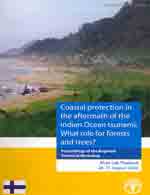The Indian Ocean tsunami of 26 December 2004 was one of the most devastating natural disasters in human history. The widespread wreckage and loss of life were hard to conceive and the subsequent outflow of national and international assistance was unprecedented. All around the Indian Ocean efforts were made to restore order and rebuild the lives and livelihoods of the millions affected. A proportion of the reconstruction and rehabilitation effort was focussed on environmental rehabilitation and a part of this again on the rehabilitation of coastal trees and forests. Many programmes were implemented during the post-tsunami period to restore coastal trees and forests, and in particular mangrove forests. Early information suggested that extensive areas of forest had been destroyed by the tsunami. It later became clear that the area of forest destroyed by the tsunami was small in relation to that removed by human activity over past decades. Other information from a range of sources strongly suggested that coastal forests had afforded some degree of protection from the devastation caused by the tsunami. These factors, and reductions in risk associated with increased distance of human habitations from the coastline, provided justification for tree planting programmes and led to calls to establish coastal buffer zones in a number of tsunami-affected countries. The effectiveness of trees and forests in shielding coastlines from tsunamis was later called into question, however, as was the practicality of planting trees to protect coasts in relation to other possible measures.
FAO has been deeply involved in these efforts through the Finnish-funded �Forestry programme for early rehabilitation in Asian tsunami-affected countries� [OSRO/GLO/502/FIN] and many other projects. Thanks to the generosity of the Finnish Government, FAO was able to organize the workshop on �Coastal protection in the aftermath of the Indian Ocean tsunami: What role for forests and trees?� to assess and synthesize information on the protective functions of coastal forests. The workshop�s overall goal was to contribute to coastal area planning and forest management by increasing understanding of the roles that forests and trees may play in protecting coastal areas from tsunamis and other natural hazards and processes, namely cyclones, wind and salt spray and coastal erosion. Workshop participants represented a wide range of disciplines. They included physicists and coastal engineers, disaster management specialists, government representatives and policy makers, field-based practitioners, academics and international development workers. The technical papers included in these proceedings provide information on the processes and outcomes of interactions between trees and forests and each of the four coastal hazards. The outputs from the working group sessions and the recommendations reflect the intensity of debate that took place in the meeting and the wide range of opinions that were expressed.
Emerging from the workshop was the message that many variables are associated with the coastal protective functions that trees and forests can play and that broad conclusions are difficult to draw. It is clear, however, that for all the coastal hazards/processes discussed, trees and forests can provide protection under some circumstances. Further work is needed before definitive conclusions can be made, but FAO hopes that these proceedings will provide coastal planners with greater insights into the relevant factors, leading to more informed decisions related to the roles of trees and forests in protecting against coastal hazards.

He Changchui
Assistant Director-General and
Regional Representative for Asia and the Pacific
Food and Agriculture Organization of the United Nations